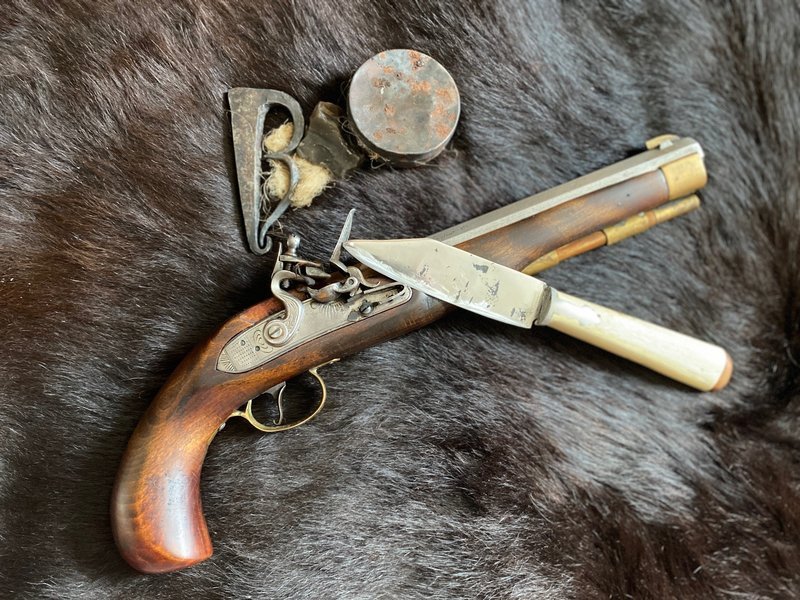Do not leave rags with petroleum based finish residues of any kind on them in the shop. Spread them on the ground outside until dry before disposing of them or immerse in water.Or leave some rags you wiped some up with laying around in your shop, makes a dandy spontaneous combustion fire.
-
Friends, our 2nd Amendment rights are always under attack and the NRA has been a constant for decades in helping fight that fight.
We have partnered with the NRA to offer you a discount on membership and Muzzleloading Forum gets a small percentage too of each membership, so you are supporting both the NRA and us.
Use this link to sign up please; https://membership.nra.org/recruiters/join/XR045103
You are using an out of date browser. It may not display this or other websites correctly.
You should upgrade or use an alternative browser.
You should upgrade or use an alternative browser.
Boiled Linseed Oil Finish?
- Thread starter UplandHunter
- Start date

Help Support Muzzleloading Forum:
This site may earn a commission from merchant affiliate
links, including eBay, Amazon, and others.
Those are classy!Hi,
Probably every new builder on this sight has posted the same question. There are many finishes that work well. BLO sold today in hardware stores is linseed oil mixed with solvents to speed drying. It is not the same as what was traditionally called "boiled linseed oil", which was actually an oil varnish. It contained some sort of resin to create a varnish and was much more weather resistant than pure linseed oil. Pure oils like linseed or tung take forever to dry and no old time or modern gunsmith can afford to spend months on a finish that ultimately is mediocre. Mixing linseed oil with a varnish like spar or polyurethane will work well, dry quickly and looks a lot like the old BLO finishes. Tried and True makes a fine linseed oil varnish that many top gunmakers use. Another option is to heat treat (polymerize) the oil and mix with solvents. Tru Oil is just linseed oil polymerized and mixed with solvents and works pretty well. You can also get polymerized tung oil, which is even better. Sutherland-Welles is one brand and is the finish I use. There are also synthetically produced finishes such as Permalyn that are popular although they can impart a plastic look to the finish if built up too much. In my work, I want a finish that is reasonably weather resistant, can be repaired if needed, and looks like the old finishes found on original guns. Here are examples of guns finished with polymerized tung oil.
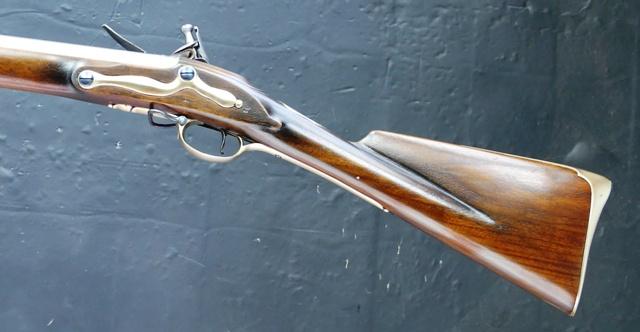
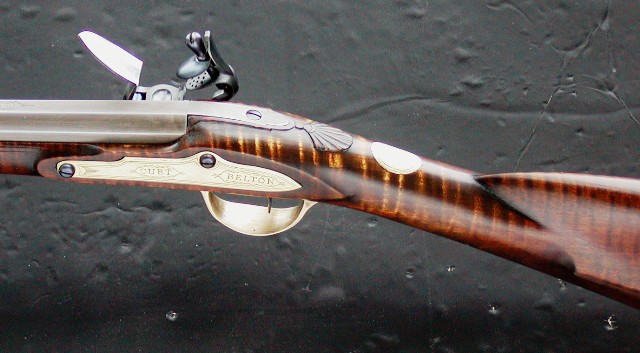
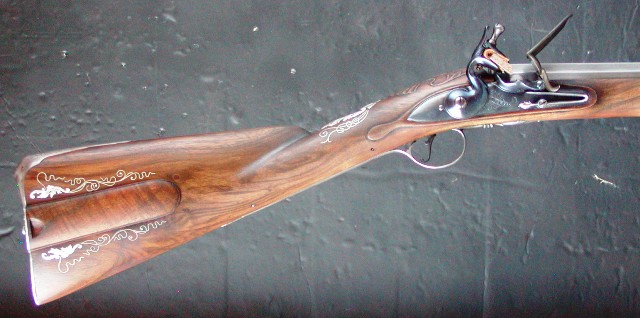
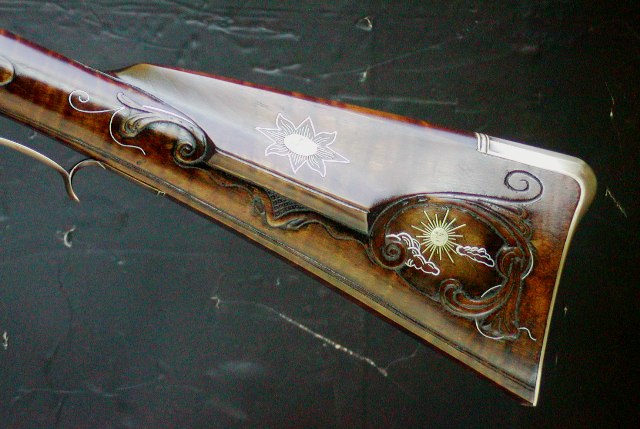
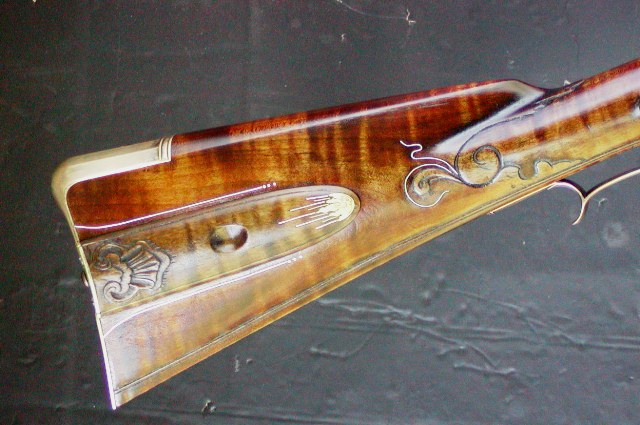
The look ranges from somewhat glossy to a low sheen depending on my objectives.
dave
Juniata
40 Cal
- Joined
- Oct 2, 2021
- Messages
- 400
- Reaction score
- 1,592
I mix Minwax oil based Helmsman satin 10oz, 1 Oz Boiled Linseed Oil and 1 Oz of minwax Tung oil. I rub on 3 to 4 coats the heaviest being the first.
I usually clean out the inlets with a knife point as it likes to gum up when you build a gun with a proper and snug inlet prior to finish.
Here's one I just finished.
I usually clean out the inlets with a knife point as it likes to gum up when you build a gun with a proper and snug inlet prior to finish.
Here's one I just finished.
bldtrailer
Pilgrim






Last edited:
blfuller
32 Cal
Pure Tung oil (China Wood oil) is a more moisture resistant finish than BLO.
satwel
40 Cal.
I've tried just about all of the finishes mentioned. The only finish I use now is Chambers Oil Finish. IMHO it provides the best combination of durability, authentic look and ease-of-use.
I've also had good luck with Permalyn.
I've also had good luck with Permalyn.
Artists Grade Refined Linsead Oil .. 3 coats a Month for about 12 months with LOTS of Ebow Grease and you will have the Best London grade Oil Finish..O.D.
- Joined
- Jan 12, 2005
- Messages
- 1,235
- Reaction score
- 1,655
Quick question?
What gunsmith would use a finish that literally took a month to a year to apply?
That never dries, and is water permeable? Gets sticky in the rain or heat.
Guys, there are so many better finishes out there.
What gunsmith would use a finish that literally took a month to a year to apply?
That never dries, and is water permeable? Gets sticky in the rain or heat.
Guys, there are so many better finishes out there.
Philip A.
36 Cl.
In defense of BLO... If properly applied, it has many advantages.
I've used it for decades on rifles and guns that see heavy usage in the tropical bush, under sun, extreme heat, torrential rains, and all sorts of scrapes and dings.
It takes some time to complete, but only because you have to be patient and need a few weeks to complete a stock: each coat takes minutes to apply.
The trick is to finish it with wax, but NOT beeswax, which has a low melting temperature, will "sweat" in heat and feel sticky on your hands, and behaves poorly when wet.
Use carnauba wax when the last coat of BLO has dried. Carnauba melts at 180F and is impervious to any heat you'd care to submit your gun to. It gives you a waterproof finish, a sheen between gloss and satin, and has a very nice feel on the hands: it gives you traction without any stickiness, doesn't change texture when wet, and has that "bare wood" feel that you definitely don't get with any synthetic finish.
The finish has such a good traction that I do not use checkering on any of my guns, and these are guns that I carry outdoors for hours every day, and months every year.
You can make your own mix with pure carnauba and turpentine, but you can also use high-grade car wax with carnauba (check ingredients to make sure there are no silicones in it, only carnauba and solvents/emulsifiers).
I've used it for decades on rifles and guns that see heavy usage in the tropical bush, under sun, extreme heat, torrential rains, and all sorts of scrapes and dings.
It takes some time to complete, but only because you have to be patient and need a few weeks to complete a stock: each coat takes minutes to apply.
The trick is to finish it with wax, but NOT beeswax, which has a low melting temperature, will "sweat" in heat and feel sticky on your hands, and behaves poorly when wet.
Use carnauba wax when the last coat of BLO has dried. Carnauba melts at 180F and is impervious to any heat you'd care to submit your gun to. It gives you a waterproof finish, a sheen between gloss and satin, and has a very nice feel on the hands: it gives you traction without any stickiness, doesn't change texture when wet, and has that "bare wood" feel that you definitely don't get with any synthetic finish.
The finish has such a good traction that I do not use checkering on any of my guns, and these are guns that I carry outdoors for hours every day, and months every year.
You can make your own mix with pure carnauba and turpentine, but you can also use high-grade car wax with carnauba (check ingredients to make sure there are no silicones in it, only carnauba and solvents/emulsifiers).
Last edited:
- Joined
- Jan 12, 2005
- Messages
- 1,235
- Reaction score
- 1,655
Okay, I just finished building your new gun. We colluded on every detail. Looks really purty, but you can’t have it for at least a year, because I decided to use BLO on the stock.
Oh, and don’t take it out in the rain. But it’ll be nice.
Sorry about the snark.
Just seems strange to me, that once we have made up our minds………
I don’t get why, with all the great products out there, we get stuck.
Oh, and don’t take it out in the rain. But it’ll be nice.
Sorry about the snark.
Just seems strange to me, that once we have made up our minds………
I don’t get why, with all the great products out there, we get stuck.
- Joined
- Feb 7, 2024
- Messages
- 119
- Reaction score
- 139
It's your basic entry level blackpowder rifle - I have several myself! Want to do something fun? Get some ferric nitrate crystals or iron nitrate "stain". There is a massive amount of info on it here. put on the bare wood and then heat gun the next day to darken it and make the grain pop. Then can finish with whatever top coat. Really for this grade I'd do Tru-oil or Lin-Speed oil which are quick drying oils. You don't really need to do an iron nitrate stain but its fun. On bluing - its a hunting gun so Brownells Oxpho-Blue is great. Doesn't really need to look "brown" since no one is mistaking this for an antique so doesn't need to look antique. I like to heat mine up with a heat gun and the metal has to be 100% clean of oils and waxes or the bluing will be uneven. Even the steel wool needs to be oil free. You can find all this stuff online.
If you want to go down the rabbit hole - I mix Pure Tung Oil and Pure swedish boiled linseed oil 50/50. Takes a while to dry. Then finish with 33% beeswax, 67% BLO/Tung oil. I even have some roll on sticks of the beeswax/blo/tung if you want one I can shoot one your way. Made several of them.
Most of my previous wood work have been mauser sporters. I've only recently gone to the dark side (black powder). I still suck at most of it but I enjoy sucking at it.
Phil
If you want to go down the rabbit hole - I mix Pure Tung Oil and Pure swedish boiled linseed oil 50/50. Takes a while to dry. Then finish with 33% beeswax, 67% BLO/Tung oil. I even have some roll on sticks of the beeswax/blo/tung if you want one I can shoot one your way. Made several of them.
Most of my previous wood work have been mauser sporters. I've only recently gone to the dark side (black powder). I still suck at most of it but I enjoy sucking at it.
Phil
If you want your gun tomorrow get some fast-dry polyurethane. Seems like everyone wants quick that’s the trick.
Seriously put whatever you like on it. Some of us have used BLO and would use it again. Others have never used it and never will. It’s just whatever butters your biscuit.
I’ve done this test over and over and posted it on the forum. But I’ll show the results of the last few days for those who contend for spotty, sticky, never drying linseed oil. Mind you this the one quart size Kleen-Strip brand not some so-called highly refined artists grade.
First here is a piece of walnut sanded to 320. 2 coats of oil 4 hrs apart, Allowed to dry over night. Then exposed to constant wetting for 4 hrs.

Next after drying over night. No spotting, no stickiness, but grain raised.
Next two buttstocks that have been finished with nothing but hardware store BLO. Both had a wipe down of linseed oil before test. The one on the left was finished originally more than 40 yrs ago. It has not been freshened up in more than 5. The other was first finished about 12 yrs ago. It gets a wipe down with BLO at the end of hunting season each year just to take care of little scuffs etc..
Again water puddle for 4 hours, dry over night.

Next what it looked like after drying. Looks like a problem, right. Look at the discoloration, especially on the right.

Now look at what rubbing with the heel of my hand did. And please note, no oil added.

If I had blindly handed someone either or both these today and asked them to show me where water had pooled on them for four hours they couldn’t have done it.
Use what you like. Most are going to do that any way.
I’ve done this test over and over and posted it on the forum. But I’ll show the results of the last few days for those who contend for spotty, sticky, never drying linseed oil. Mind you this the one quart size Kleen-Strip brand not some so-called highly refined artists grade.
First here is a piece of walnut sanded to 320. 2 coats of oil 4 hrs apart, Allowed to dry over night. Then exposed to constant wetting for 4 hrs.

Next after drying over night. No spotting, no stickiness, but grain raised.

Next two buttstocks that have been finished with nothing but hardware store BLO. Both had a wipe down of linseed oil before test. The one on the left was finished originally more than 40 yrs ago. It has not been freshened up in more than 5. The other was first finished about 12 yrs ago. It gets a wipe down with BLO at the end of hunting season each year just to take care of little scuffs etc..
Again water puddle for 4 hours, dry over night.

Next what it looked like after drying. Looks like a problem, right. Look at the discoloration, especially on the right.

Now look at what rubbing with the heel of my hand did. And please note, no oil added.

If I had blindly handed someone either or both these today and asked them to show me where water had pooled on them for four hours they couldn’t have done it.
Use what you like. Most are going to do that any way.
Exactly my approach to finishing stocks. I read about the process in Sam Fadelas black powder handbook 30 years ago. Always happy with the results.View attachment 336004View attachment 336005View attachment 336006View attachment 336007View attachment 336008I used BLO at Bobby Hoyts suggestion and I'm happy with the results . most people forget that it needs UV light to harden and low humidity helps it dry . Yes you need to be attentive 1st day hand apply till it will not take more , than next day add and buff than everyday for a week , than once week for a month ,then once a month for a year . just a few drops on a lint free rag or clean fingers than buff by hand to a luster .BLO adds depth to the wood that the photos don't show very wellView attachment 336062
- Joined
- Nov 1, 2018
- Messages
- 3,866
- Reaction score
- 2,899
BLO is ok but I like Daish oil better. I use the one with pigment from Home Depot and produces great results. I have done several grips with the dark walnut color. Just refinished these two a couple of days ago.
View attachment 335664
View attachment 335663
Danish oil is a bit of a challenge when using danish oil i try to keep the grain raised and open while it dries, as it penetrates into the wood pretty deep. It’s not a bad idea to put on a top coat of something such as a varnish or linspeed BLO after Danish oil dries. I would use a light tinted danish oil, it tends to get very dark in multiple coats.
Its great for brining out the grain in the wood on lesser quality stocks.
Nice looking finish!!!!! I'm curious, during the course of its' lifetime do you ever apply a good hard wood paste wax over the top of your linseed finish and rub down with linseed again?Seriously put whatever you like on it. Some of us have used BLO and would use it again. Others have never used it and never will. It’s just whatever butters your biscuit.
I’ve done this test over and over and posted it on the forum. But I’ll show the results of the last few days for those who contend for spotty, sticky, never drying linseed oil. Mind you this the one quart size Kleen-Strip brand not some so-called highly refined artists grade.
First here is a piece of walnut sanded to 320. 2 coats of oil 4 hrs apart, Allowed to dry over night. Then exposed to constant wetting for 4 hrs.
View attachment 337235
Next after drying over night. No spotting, no stickiness, but grain raised.View attachment 337237
Next two buttstocks that have been finished with nothing but hardware store BLO. Both had a wipe down of linseed oil before test. The one on the left was finished originally more than 40 yrs ago. It has not been freshened up in more than 5. The other was first finished about 12 yrs ago. It gets a wipe down with BLO at the end of hunting season each year just to take care of little scuffs etc..
Again water puddle for 4 hours, dry over night.
View attachment 337240
Next what it looked like after drying. Looks like a problem, right. Look at the discoloration, especially on the right.
View attachment 337241
Now look at what rubbing with the heel of my hand did. And please note, no oil added.
View attachment 337242
If I had blindly handed someone either or both these today and asked them to show me where water had pooled on them for four hours they couldn’t have done it.
Use what you like. Most are going to do that any way.
Robinoil again?
No wax.
BLO to pop the grain, then a Varnish of your choice to seal and then Paste Wax if you want.
(I use Paste Wax because it adds a nice soft luster AND you will never get that wet fowling staining running down the stock when cleaning. It simply wipes off. Can’t do that with Varnish or BLO that I have ever experienced)
(I use Paste Wax because it adds a nice soft luster AND you will never get that wet fowling staining running down the stock when cleaning. It simply wipes off. Can’t do that with Varnish or BLO that I have ever experienced)
Sidney Smith
58 Cal.
- Joined
- Feb 17, 2019
- Messages
- 2,205
- Reaction score
- 2,312
I tried BLO finish on one build. I absolutely hated it. Took forever between coats to dry. I hand rubbed it on each coat.
I've been using Birchwood Casey True Oil on recent builds and I like it much better. Dries quickly and gives a more uniform hard finish.
I've been using Birchwood Casey True Oil on recent builds and I like it much better. Dries quickly and gives a more uniform hard finish.
Similar threads
- Replies
- 2
- Views
- 261
- Replies
- 22
- Views
- 1K
- Replies
- 7
- Views
- 984



